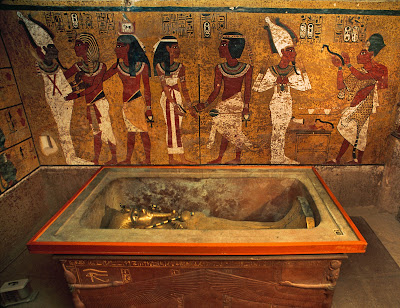It carries no 62 in the Valley of the Kings (KV 62). It is a small tomb it is cut down into the bedrock of the valley, probably been made initially for the high priest Ay.
The entrance stairway consists of 16 steps going down to the Corridor and this corridor leads to the Antechamber and the antechamber leads to the Annexe at the northern end while the eastern side leads to the Burial Chamber, which leads in its turn to the Treasury on the eastern side.
The burial chamber is the only decorated room in the tomb. Everything found there was crammed over each other, every space was used that is because of the king’s sudden death, which caused the people to put everything in very rapidly even the daily life equipments were put in together with the funerary equipment.
Also there was no time to decorate the whole tomb. Only the burial chamber was decorated because the dead king would need all the spells depicted on the walls closer to his body for his protection in the afterlife. The walls were painted very quickly and the tomb was rapidly closed.
That’s why when the burial chamber was opened, the walls were covered with fungus because the paints didn't have time to fully dry, and this maybe one of the reasons that caused people’s death after the discovery; not as was said because of the curse of the pharaohs. "Death will come on swift wings for those who will disturb the king" but these words were just a spell, or not?!
Some events triggered the famous so-called “Curse of the Pharahs” related to the opening of the tomb of Tutankhamun:
• Carter’s canary was eaten by a cobra on the day of discovery
• Death of Lord Carnarvon as a result of a mosquito bite, after slashing his cheek while shaving and the wound became infected.
The entrance stairway consists of 16 steps going down to the Corridor and this corridor leads to the Antechamber and the antechamber leads to the Annexe at the northern end while the eastern side leads to the Burial Chamber, which leads in its turn to the Treasury on the eastern side.
The burial chamber is the only decorated room in the tomb. Everything found there was crammed over each other, every space was used that is because of the king’s sudden death, which caused the people to put everything in very rapidly even the daily life equipments were put in together with the funerary equipment.
That’s why when the burial chamber was opened, the walls were covered with fungus because the paints didn't have time to fully dry, and this maybe one of the reasons that caused people’s death after the discovery; not as was said because of the curse of the pharaohs. "Death will come on swift wings for those who will disturb the king" but these words were just a spell, or not?!
Some events triggered the famous so-called “Curse of the Pharahs” related to the opening of the tomb of Tutankhamun:
• Carter’s canary was eaten by a cobra on the day of discovery
• Death of Lord Carnarvon as a result of a mosquito bite, after slashing his cheek while shaving and the wound became infected.
• However, many others who visited the tomb or helped to discover it lived long and healthy lives. A study showed that of the 58 people who were present when the tomb and sarcophagus were opened, only eight died within a dozen years.
All the others were still alive, including Howard Carter, who later died of lymphoma at the age of 64 in 1939
Scholars believe that the tomb was affected by 2 robberies, which happened very early in the 19th or 20th dynasty, because there were signs of re-closure at the top left- hand corner of the blocking. The robberies were soon discovered and the corridor was filled up to the top with limestone chippings and the tomb was resealed.
The 1st robbery was confined to the antechamber and the annexe while the 2nd robbery was more extensive where robbers burrowed through the corridor fill, this time they entered the entire tomb and reached up to the outermost shrine of the king.
The thieves managed to steal some of the jewellery together with unguents and perfumes, which they poured in leather bags, as they couldn’t manage to get the stone vessels out of the tomb.
Some fingerprints could still be seen on the vessels together with traces of the unguents robbed, on the rims of some of the containers.
Tutankhamun’s Burial:
Around the sarcophagus of Tutankhamun there are 4 shrines one inside the other in order to protect the mummy. After the outermost shrine everything remained completely intact so they didn't reach the precious jewellery, which were placed directly on the mummy as a kind of protection as jewellery was used as amulets for protection.
Tutankhamun’s mummy was originally put in one sarcophagus and three coffins. It used to be kept in the outermost quartzite sarcophagus in the burial chamber of his tomb.
Recent news confirmed that the mummy was moved from inside the sarcophagus to a nearby glass showcase with very accurate temperature controls to make sure that the mummy stays in perfect condition after signs of decay have been observed by Egyptologists.
The 4 funerary containers are:
1- Quartzite sarcophagus, still in situ at the tomb.
2- 1st gilded wooden anthropoid coffin
3- 2nd gilded wooden anthropoid coffin wood inlayed with semi-precious stones and covered with thick gold leaf.
4- The innermost anthropoid coffin which is made of pure gold (110 Kg of solid gold)
Finally there was the golden mask covering the face of the mummified king with a total weight of 11 kg of pure solid gold.




No comments:
Post a Comment